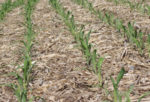Advertise Follow Us
Items Tagged with 'compaction layers'
ARTICLES
No-Till Notes
Locate, Correct Compaction For More No-Till Success
Like any field operation, identifying and addressing compaction layers are important to maximize water infiltration, root growth and crop yields.
Read More
What I've Learned from No-Tilling
Listening To No-Tillers Makes For Better Equipment
Roy Applequist says Great Plains Mfg. has grown up with the no-till industry, adapting along the way to provide better tools for their no-till customer base.
Read More
Soil Test Leads To Cover Crop Dabbling
A Missouri no-tiller’s quest to ward off a developing compaction layer could help many other growers take advantage of cover-crop benefits.
Read More
Vertical Tillage: A Gateway Tool To, Or Away, From Conservation?
A growing number of no-tillers are using vertical tillage to overcome challenges in their fields, while maintaining residue on the surface.
Read More








